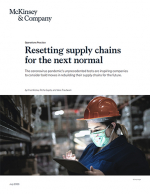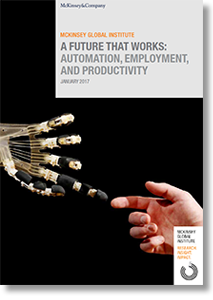A Future That Works: Automation, Employment, and Productivity
This report contributes to McKinsey Global Institute’s mission to help business and policy leaders understand the forces transforming the global economy, identify strategic locations, and prepare for the next wave of growth.
Advances in robotics, artificial intelligence, and machine learning are ushering in a new age of automation, as machines match or outperform human performance in a range of work activities, including ones requiring cognitive capabilities.
In this report, part of our ongoing research into the future of work, we analyze the automation potential of the global economy, the factors that will determine the pace and extent of workplace adoption, and the economic impact associated with its potential.
- Automation of activities can enable businesses to improve performance, by reducing errors and improving quality and speed, and in some cases achieving outcomes that go beyond human capabilities. Automation also contributes to productivity, as it has done historically. At a time of lackluster productivity growth, this would give a needed boost to economic growth and prosperity and help offset the impact of a declining share of the working-age population in many countries. Based on our scenario modeling, we estimate automation could raise productivity growth globally by 0.8 to 1.4 percent annually.
- About half the activities people are paid almost $15 trillion in wages to do in the global economy have the potential to be automated by adapting currently demonstrated technology, according to our analysis of more than 2,000 work activities across 800 occupations. While less than 5 percent of all occupations can be automated entirely using demonstrated technologies, about 60 percent of all occupations have at least 30 percent of constituent activities that could be automated. More occupations will change than will be automated away.
- Activities most susceptible to automation involve physical activities in highly structured and predictable environments, as well as the collection and processing of data. In the United States, these activities make up 51 percent of activities in the economy accounting for almost $2.7 trillion in wages. They are most prevalent in manufacturing, accommodation and food service, and retail trade, and include some middle-skill jobs.
- Technical, economic, and social factors will determine the pace and extent of automation. Continued technical progress, for example in areas such as natural language processing, is a key factor. Beyond technical feasibility, the cost of technology, competition with labor including skills and supply and demand dynamics, performance benefits including and beyond labor cost savings, and social and regulatory acceptance will affect the pace and scope of automation. Our scenarios suggest that half of today’s work activities could be automated by 2055, but this could happen up to 20 years earlier or later depending on the various factors, in addition to other wider economic conditions.
- People will need to continue working alongside machines to produce the growth in per capita GDP to which countries around the world aspire. Our productivity estimates assume that people displaced by automation will find other employment. The anticipated shift in the activities in the labor force is of a similar order of magnitude as the long-term shift away from agriculture and decreases in manufacturing share of employment in the United States, both of which were accompanied by the creation of new types of work not foreseen at the time.
- For business, the performance benefits of automation are relatively clear, but the issues are more complicated for policy-makers. They should embrace the opportunity for their economies to benefit from the productivity growth potential and put in place policies to encourage investment and market incentives to encourage continued progress and innovation. At the same time, they must evolve and innovate policies that help workers and institutions adapt to the impact on employment. This will likely include rethinking education and training, income support and safety nets, as well as transition support for those dislocated. Individuals in the workplace will need to engage more comprehensively with machines as part of their everyday activities, and acquire new skills that will be in demand in the new automation age.
Log in to download this paper.
What’s Related
Related Companies
McKinsey
Related Topics
Automation
Artificial IntelligenceAutomationMachine LearningMcKinseyRoboticsWarehouse|DC
All topics
News





An Increasingly Digital Procurement Function Lacks Talent Required for Future Needs
Only 65% of survey respondents said their organizations have dedicated strategies to train on the most critical competencies
7 Actions to Drive Demand Planning During the COVID-19 Pandemic and Prepare for the “Nex...
Target Acquiring Same-Day Delivery Service Shipt for $550 Million to Fend Off Amazon and W...
Robotic Automation to Supplant 800 Million Jobs Worldwide by 2030
How Advancing Technologies Challenge the Position of a Company Chief Executive Officer
More News
Resources

Could Climate Become The Weak Link In Your Supply Chain?
Supply chains and the infrastructure that supports them are designed for a stable climate, but as hazards evolve, it will be necessary to increase investment in adaptation, possibl...

McKinsey Survey: Resetting Supply Chains For The “Next Normal”
According to McKinsey & Company, the coronavirus pandemic’s unprecedented tests are inspiring companies to consider bold moves in rebuilding their supply chains for the future.

Defining ‘On-Time, In-Full’ In the Consumer Sector
Managing modern consumer-goods supply chains is demanding, but measuring supply-chain performance should be simple, it isn’t yet, because of an inconsistent approach to the criti...
More Resources
Favorites

How Does IKEA’s Inventory Management Supply Chain Strategy Really Work?
Each IKEA store is huge and holds more than 9,500 products! How in the world does IKEA offer so...

Starbucks as an Example of the Value Chain Model
The concept of value chain helps to understand and segregate the useful (which help in gaining a competitive...

7 Principles of Supply Chain Management Explained
Would you like to understand supply chain management concepts but don't have time to study from a textbook?...

Is Apple’s Supply Chain Really the No. 1? A Case Study
How Complex is Apple's Supply Chain? Some people in the blogosphere said that Apple's Supply Chain is not...

